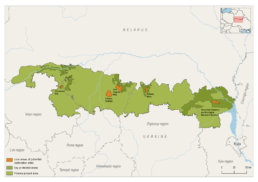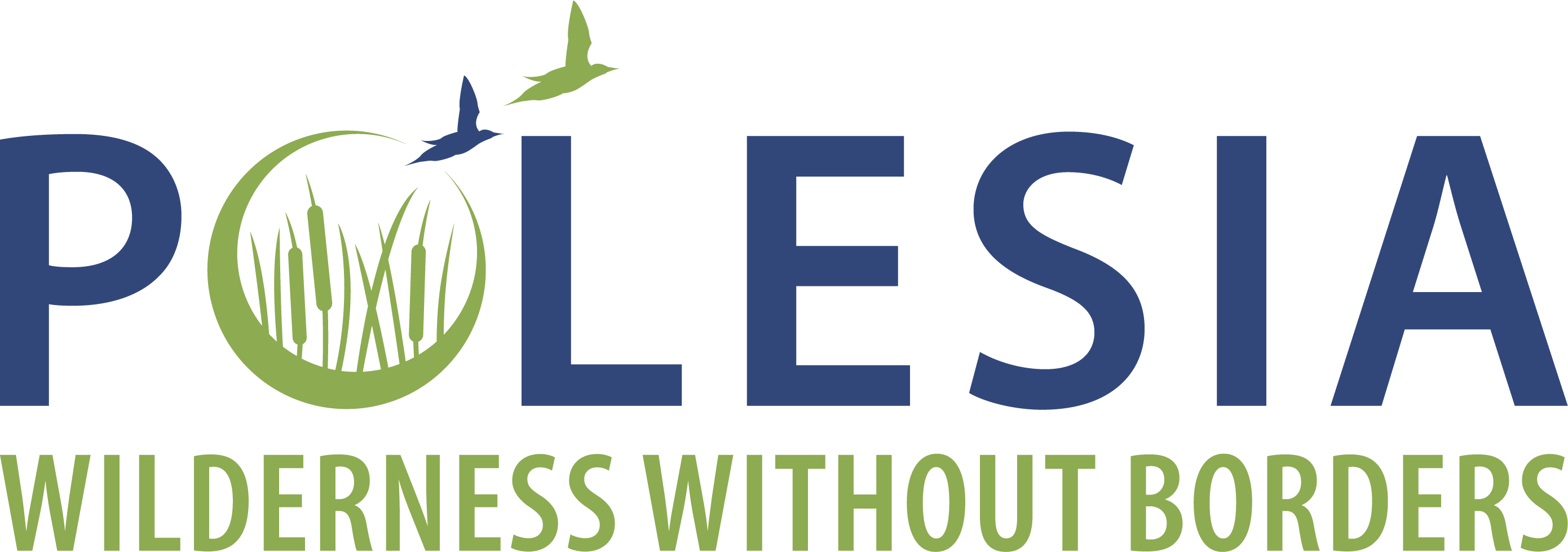Cheremskyi Strict Nature Reserve
The Cheremskyi Strict Nature Reserve is situated between the Pripyat, Styr, and Stokhid rivers, forming a rich wetland complex that includes mesotrophic mires, swamp forests, and two glacial karst lakes. Forests dominate the landscape, covering approximately 64% of the area. These include swamp forests composed of pine, birch, and black alder, as well as spruce forests growing beyond their natural range. Some parts of the natural forest have been replaced by plantations.
At the heart of the reserve lies one of Ukraine’s largest and best-preserved transitional mires: the Cheremskyi sedge-sphagnum mire. All three main mire types are present within the reserve: fens, transitional mires (the most widespread), and bogs. Mires cover about 34% of the territory, while open water bodies and watercourses account for roughly 1%.

Country: Ukraine
Area: 2,975.7 ha
National protection status: strict nature reserve
International protection status:
Emerald Network Site (UA0000024) - Cheremskyi Nature Reserve (2,949 ha);
Ramsar Site (2272) - Cheremske Bog (2,975.7 ha);
IBA (UA006) - Cherems'ke Mire (3,000 ha).
760 species
of vascular plants identified here
20 key habitats
recognized under the Resolution No. 4 of the Bern Convention
70+ species
with national and international protection
Land cover

Forests

Mires

Waterbodies

Others
Biodiversity and natural values


Habitats
The area is home to a rich mosaic of wetland and forest habitats, many of which are of high conservation value. Over 20 natural habitat types listed for protection under Resolution No. 4 of the Standing Committee to the Bern Convention have been recorded here. These include a variety of aquatic, peatland, and forest ecosystems:
Aquatic Habitats
- Permanent oligotrophic lakes, ponds, and pools (3140)
- Permanent dystrophic lakes, ponds, and pools (3160)
- Floating frogbit rafts (3150)
- Floating water-soldier rafts (3150)
- Floating bladderwort colonies (3150)
- Floating Aldrovanda vesiculosa communities (3150)
Wetlands and Peatlands
- Transition mires and quaking bogs (7140)
- Raised bog complexes (7110)
Woodland Habitats
- Sphagnum birch woods (91D0)
- Nemoral bog conifer woodland (91D0)
- Enclave Norway spruce forests
- Oak–ash–hornbeam woodland on eutrophic and mesotrophic soils (9170)

Fauna
Preliminary surveys have recorded a rich diversity of vertebrates in the area, including 18 species of fish, 12 species of amphibians, 7 species of reptiles, 141 species of birds, and 42 species of mammals.
More than 50 of these species are protected under Resolution No. 6 of the Standing Committee to the Bern Convention. Notable examples include the Aquatic Warbler (Acrocephalus paludicola), Great Snipe (Gallinago media), Black Stork (Ciconia nigra), Short-toed Eagle (Circaetus gallicus), Tengmalm’s Owl (Aegolius funereus), White-backed Woodpecker (Dendrocopos leucotos), Black Woodpecker (Dryocopus martius), Three-Toed Woodpecker (Picoides tridactylus), Gray-headed Woodpecker (Picus canus), Hazel Grouse (Bonasa bonasia), and Capercaillie (Tetrao urogallus).
The area is also home to several rare insect species, such as Stephanopachys linearis, Phryganophilus ruficollis, Boros schneideri, the Great Capricorn Beetle (Cerambyx cerdo), the Danube Clouded Yellow (Colias myrmidone), Cucujus cinnaberinus, the Large Copper butterfly (Lycaena dispar), Dytiscus latissimus, the Water Beetle (Graphoderus bilineatus), and the Ornate Bluet damselfly (Coenagrion ornatum).
This territory provides crucial habitat for a variety of fish species, including the Lake Minnow (Phoxinus percnurus), European Bitterling (Rhodeus sericeus amarus), Spined Loach (Cobitis taenia), and European Weatherfish (Misgurnus fossilis). It is also important for reptiles and amphibians such as the European Pond Turtle (Emys orbicularis), Crested Newt (Triturus cristatus), and Fire-bellied Toad (Bombina bombina).



Flora
The reserve is home to an impressive diversity of vascular plants, with 760 species recorded. Additionally, the area supports 100 species of mosses, 53 species of lichens, and 133 species of fungi. It provides a vital habitat for several rare plants, including the Waterwheel (Aldrovanda vesiculosa), Eastern pasqueflower (Pulsatilla patens), Fen Orchid (Liparis loeselii), Lady’s Slipper (Cypripedium calceolus), Dicranum Moss (Dicranum viride), Garland-flower (Daphne cneorum), and Lake Quillwort (Isoetes lacustris).
The most important impacts and threats

Forest felling and dead wood removal

Poaching

Unregulated mushroom and berry picking

Wildfires
Our activities in the area
A management plan for the Cheremskyi Strict Nature Reserve has been developed to guide conservation efforts. To improve monitoring of large mammals, camera traps were installed across key areas of the reserve as part of a broader Polissian-wide study. These provide valuable data on species distribution and abundance. In addition, a feasibility study for the restoration of the Cheremske Bog has been completed, laying the groundwork for future habitat restoration.
To support fieldwork and research, the reserve has been equipped with essential tools such as binoculars, scopes, GPS, etc.. The introduction of the SMART monitoring system is underway, further enhancing biodiversity data collection and protection measures.
Since the beginning of the war, regular financial assistance has been provided to the Cheremskyi Strict Nature Reserve to help cover critical operational costs, including fuel, vehicle maintenance, telecommunications, office supplies and access to a mobile car workshop for on-site vehicle repairs, ensuring uninterrupted operations during a time of crisis.
Protection and conservation needs
The area is currently protected as a strict nature reserve, where all forms of economic activity are prohibited. However, to ensure the long-term conservation of its biodiversity and ecological integrity, further measures are needed.
Importantly, the entire peatland massif is not fully included within the reserve boundaries, and some of its ecologically valuable parts remain unprotected. This fragmentation increases vulnerability to external threats and underscores the need for expanded and coordinated conservation efforts.
To strengthen protection and improve management, the following actions are recommended:
- Conduct a comprehensive inventory of conservation values, including species habitats, rare ecosystems, and natural complexes;
- Expand protection measures to cover the entire peatland massif and ensure consistent management across its extent;
- Prohibit all types of logging, including sanitary logging, and avoid tree planting that could alter natural succession processes;
- Update and implement the management plan, aligning it with current conservation priorities and ecological conditions.




